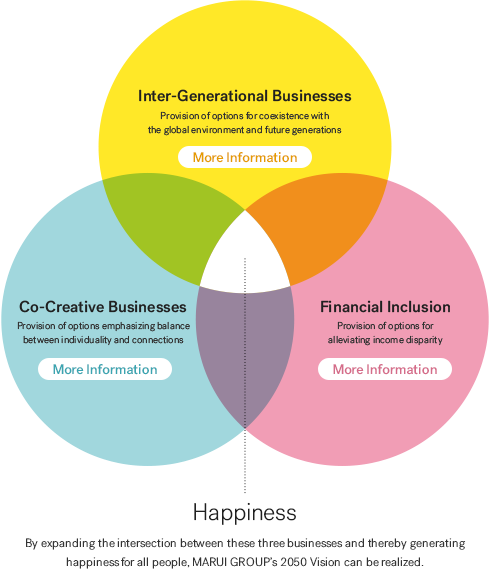Three Businesses
With eyes to 2050, MARUI GROUP has defined thee businesses founded on co-creation as the instruments for realizing its vision of "harnessing the power of business to build a world that transcends dichotomies."
- MARUI GROUP's Three Businesses
- Inter-Generational Businesses (Green Businesses)
- Inter-Generational Businesses (Initiatives Related to the TCFD—Disclosure of Financial Information Pertaining to Climate Change)
- Inter-Generational Businesses (Human Businesses)
- Co-Creative Businesses
- Financial Inclusion
- MARUI GROUP's Three Businesses
- Inter-Generational Businesses (Green Businesses)
- Inter-Generational Businesses (Initiatives Related to the TCFD—Disclosure of Financial Information Pertaining to Climate Change)
- Inter-Generational Businesses (Human Businesses)
- Co-Creative Businesses
- Financial Inclusion
MARUI GROUP's Three Businesses
These three businesses capitalize on MARUI GROUP's core value—the co-creation of creditability—as well as on the strengths and platforms cultivated through existing businesses. Furthermore, the businesses overlap with one another, as opposed to being completely isolated. By expanding the intersection between these three businesses and thereby generating happiness for all people, including future generations, MARUI GROUP's 2050 Vision can be realized.
Three Businesses Founded on
Co-Creation for Generating Happiness
Inter-Generational Businesses
In the world of 2050, we expect only those businesses that coexist with the global environment will be able to survive. Moreover, forging a sustainable future in harmony with the global environment for future generations will require us to cultivate the younger generations that will shape society 30 years from now, growing them into leaders that can guide society. Recognizing this fact, MARUI GROUP has subdivided its inter-generational businesses into green businesses and human businesses, through which it will provide options for coexistence with the global environment and future generations.
Green Businesses (Options for Coexistence with the Global Environment)
MARUI GROUP defines inter-generational green businesses as businesses that provide sustainable options for coexistence with the global environment which transcend the current and future generations. Activities and investments for reducing environmental impacts can place downward pressure on short-term earnings in the form of costs. However, if we avoid these actions, we will burden future generations with the disadvantages of environmental issues. Adopting renewable energy, for example, requires short-term costs to make the necessary initial investments. Viewed from a long-term perspective, however, these investments will create sustainable value for future generations. Initiatives for reducing CO2 emissions, meanwhile, are themselves sources of innovation for creating new green businesses and thus have the potential to increase long-term earnings. In recognition of this fact, MARUI GROUP has set key performance indicators (KPIs) for its long-term targets that are linked to activities for reducing environmental impacts and to earnings. By managing these KPIs, we will advance environmental issues as a business.
For its green businesses, MARUI GROUP has defined the indicators of environmental efficiency. In addition, we have received certification from the Science Based Targets initiative in March 2018 for our targets for reducing emissions of CO2 and other greenhouse gases throughout the Group. The Company also became a member of RE100 in July 2018, declaring its target of sourcing 100% of its electricity from renewable energy by 2030 (along with a medium-term target of sourcing 70% by 2025).
MARUI GROUP's new greenhouse gas emissions reduction target was certified by the Science Based Targets initiative as a target for keeping average temperatures below 1.5℃ above pre-industrial levels on September 30, 2019.

| Long-Term Targets | Medium-Term Targets (5 years in the future) |
Long-Term Targets (10 years in the future) |
Ultralong-Term Targets (30 years in the future) |
|---|---|---|---|
| Environmental efficiency*1 | 11.6 | 15 or more | 20 or more |
| Greenhouse gas emissions | 35% reduction | 80% reduction | 90% reduction |
| Ratio of electricity sourced from renewable energy |
70% | 100% | — |
| Resource recycling rate | 75% | 80% | 100% |
| Ratio of circular revenue*2 | 30% or more | 40% or more | 50% or more |
| Number of individuals provided with circular lifestyle options |
1 million or more | — | — |
*1 Environmental efficiency = Operating income ÷ CO2 emissions
*2 Ratio of circular revenue = Circular sales / Transactions ÷ Total Retailing segment transactions
This sustainability website is designed to accommodate people with color blindness.










